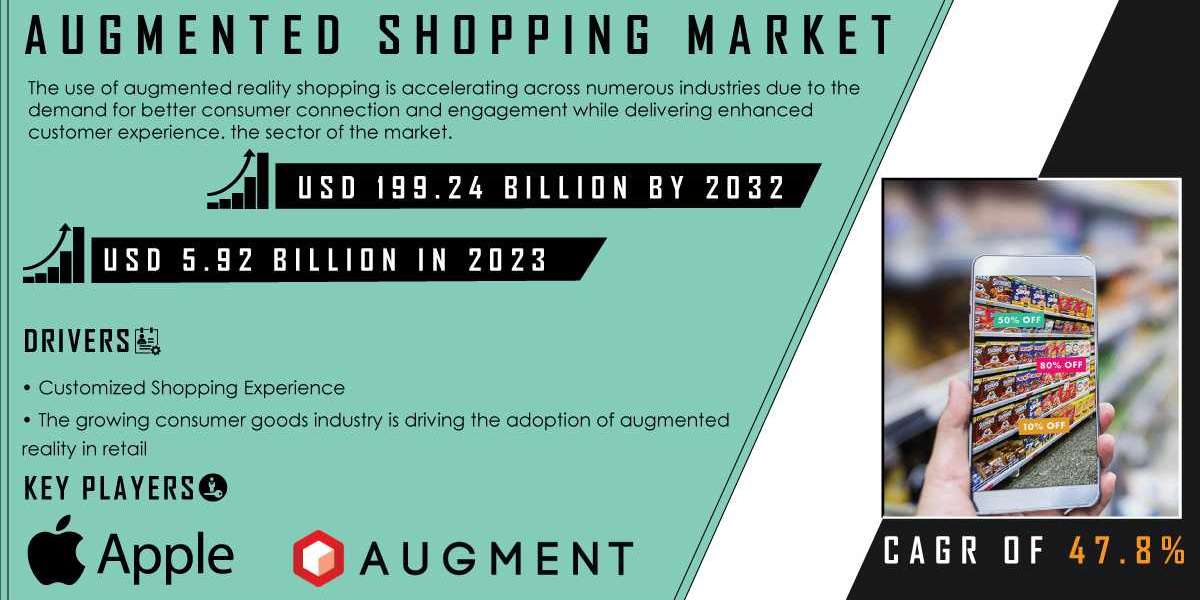Augmented Shopping 2024
Augmented shopping is revolutionizing the retail landscape by blending physical and digital shopping experiences through innovative technologies. It involves the use of augmented reality (AR) and virtual reality (VR) tools to create immersive, interactive shopping experiences that allow customers to visualize products in their environment before making a purchase. The Augmented Shopping Market Growth has been remarkable, with a market value of USD 5.92 billion in 2023. It is projected to reach USD 199.24 billion by 2032, growing at a compound annual growth rate (CAGR) of 47.8% from 2024 to 2032. This growth reflects the increasing demand for more personalized and immersive shopping experiences that go beyond traditional online or in-store methods.
Transforming the Consumer Experience
One of the key drivers behind the rise of augmented shopping is the growing demand for enhanced consumer experiences. Consumers today expect more than just the traditional way of shopping; they want to interact with products in meaningful ways that help them make informed decisions. Augmented reality provides them with the ability to visualize products in 3D, see how furniture looks in their living room, or try on clothes virtually without ever stepping foot in a store. This not only makes the shopping process more engaging but also allows customers to experiment with different products and settings, providing them with a sense of confidence in their purchasing choices.
The use of AR in augmented shopping is particularly effective in industries like fashion, home decor, and beauty, where consumers often want to try before they buy. For example, fashion retailers are increasingly offering virtual fitting rooms that use AR to allow customers to "try on" clothes using their smartphones or computers. This experience helps to reduce the uncertainty that comes with online shopping and decreases the likelihood of returns, benefiting both the consumer and the retailer.
Bridging the Gap Between Online and In-Store Shopping
Augmented shopping is also helping to bridge the gap between online and in-store shopping by creating a seamless integration of both experiences. With the advent of AR-enabled apps, customers can now experience the best of both worlds: the convenience of online shopping combined with the tactile experience of browsing in a physical store. For instance, retailers can use AR to create interactive storefronts or digital signage that allows customers to engage with products directly on their smartphones as they walk by. This fusion of digital and physical shopping makes it easier for consumers to explore products without feeling disconnected from the store environment.
For brick-and-mortar stores, augmented shopping has become a tool to drive foot traffic by creating unique, interactive experiences that attract customers. The use of AR allows retailers to offer promotions, games, and interactive content that enhance the shopping experience and encourage customers to spend more time in-store. As a result, stores are no longer just places to purchase goods but also destinations for memorable, engaging shopping activities.
Expanding Retailers’ Capabilities
For retailers, augmented shopping offers a wealth of opportunities to enhance both online and offline operations. By adopting AR technology, retailers can provide a more engaging customer journey, streamline product discovery, and reduce the friction in the buying process. In addition, augmented shopping allows businesses to gather valuable data about how customers interact with their products, which can be used to refine marketing strategies and improve inventory management. The ability to provide highly personalized experiences—based on customer preferences, past purchases, and browsing history—helps retailers stay competitive in an increasingly crowded market.
Furthermore, augmented shopping gives retailers an opportunity to expand their reach beyond local stores by creating virtual showrooms or pop-up experiences that can be accessed anywhere in the world. This opens new avenues for e-commerce growth and global market expansion, as consumers can explore and purchase products from the comfort of their homes while experiencing the store’s ambiance virtually.
The Future of Augmented Shopping
The future of augmented shopping looks incredibly promising as more retailers embrace this technology and its potential to redefine the shopping experience. The integration of AI and machine learning with augmented reality will enable even more personalized and predictive shopping experiences. For example, future systems may offer real-time product recommendations based on a consumer's preferences or predict the style and size of products they are likely to be interested in, based on their behavior.
As AR technology continues to advance, it is expected that augmented shopping will become a mainstream aspect of retail. With better, more accessible AR tools, consumers will have a wide array of immersive, interactive experiences at their fingertips, whether they’re shopping for everyday items or luxury goods. As the Augmented Shopping Market grows, this trend will likely expand across industries, offering innovative solutions for both businesses and consumers alike.
In conclusion, augmented shopping is shaping the future of retail, making it more personalized, engaging, and efficient. The rapid growth of this market, driven by advancements in AR and VR technologies, promises a new era of shopping that blurs the lines between the physical and digital worlds, ultimately providing consumers with a richer, more rewarding shopping experience.
Contact Us:
Akash Anand – Head of Business Development Strategy
info@snsinsider.com
Phone: +1-415-230-0044 (US) | +91-7798602273 (IND)
About Us
SS Insider is one of the leading market research and consulting agencies that dominates the market research industry globally. Our company's aim is to give clients the knowledge they require in order to function in changing circumstances. In order to give you current, accurate market data, consumer insights, and opinions so that you can make decisions with confidence, we employ a variety of techniques, including surveys, video talks, and focus groups around the world.
Read Our Other Reports:
Enterprise Networking Market Trends














